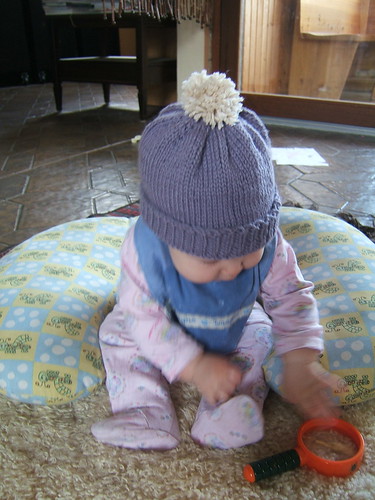
I loved how she looks in purple.

I had embroidered bubbles on it, but then when I tried it on Lavella's head, the hat was a little too big, and has to be folded up for now. The bubbles got lost in the folded brim, so I'll have to save that idea for a later date.
A few days ago, I found this recipe for Potato Parmesan Bread over at food blog, Baking Bites. I've always loved potato bread, and had to give it a try.
Starch from mashed potato feeds the yeast, giving it an extra boost for a nice airy loaf.

I made a few changes by adding Vital Wheat Gluten and some extra butter, substituted Romano for the Parmesan, bread flour for the all-purpose, used two red boiling potatoes instead of the one russet, used the cooking water from the potatoes, and heated the milk. I divided it unto two loaves instead of one, which allowed me to cut the baking time. I set the loaves on parchment covered baking sheets to rise, which I then slid onto a preheated baking stone to bake. All changes are reflected in my adapted recipe, below.
Happily, the bread rose high and lofty, with a moist interior. The cheese adds a surprisingly subtle note and lingers just a bit on the aftertaste, and the bread is equally good plain, or with butter and jam.

I would like to experiment with substituting cheddar, and adding some whole wheat to make this a little hardier. Bulgar wheat would also add a nice crunch -- I might try that as well.
Romano Potato Bread
2 red boiling potatoes (or enough potato to equal 1 cup when mashed. Potato flakes = OK)
4 tbsp butter (1/2 stick)
1 cup milk, heated to about 110-115 deg. (low fat is fine)
1 Tbsp active dry yeast
1 Tbsp sugar
2 tsp salt
1/2 cup potato water (reserved from water drained from cooking potatoes. Add extra water if needed)
1 Tbsp Vital Wheat Gluten
4-5 cups bread flour
1 cup Romano cheese, grated
1 egg + 2 tbsp water (for egg wash)
Peel potato and cut into small, even chunks. Boil potato pieces in a small saucepan until tender. Drain and reserve cooking liquid and completely mash potato (a ricer works well here, or you can force through a fine strainer) until smooth. Transfer potato to a large mixing bowl and stir in butter and milk, mixing until well combined. Mixture should be between 110 and 115 degrees, or the yeast will not activate properly.
Stir active dry yeast and sugar into the potato mixture. Let stand for 5-10 minutes, until mixture is slightly foamy. Add in salt, water, Vital Wheat Gluten and 3 cups of flour. Mix until smooth, either stirring with a wooden spoon or using the dough hook attachment on an electric stand mixer. Stir in Romano cheese and gradually add in additional flour in 1/4 cup increments until dough comes together and pulls away from the sides of the mixing bowl. If using an electric mixer, continue to knead at medium speed for about 5 minutes until dough is smooth and elastic. If mixing by hand, turn the dough onto a lightly floured surface and knead for 5-7 minutes, until dough is smooth and elastic.
Place dough in a lightly oiled bowl, cover with waxed paper or damp towel and let rise for 45-60 minutes, or until doubled in size.
TIP > If you live in a low-humidity environment, have dry heat in the house, or just want to aid rising process: heat oven on very low and then turn off. Place dough in a heat proof bowl and put in center rack of oven, covered by waxed paper or towel. Place a pan or bowl of boiling hot water in bottom of oven. Steam + gentle heat speeds the growth of the yeast.
Turn dough out onto a lightly floured surface and gently deflate. Cut in two. Shape into two long, oval loaves and place on a parchment-lined (or generously sprinkled with cornmeal) baking sheet. Cover with a clean dish towel, and let rise for 45 minutes.
Meanwhile, preheat the oven to 375F, with large baking stone inside, if using.
Stir together egg and water with a fork and lightly brush mixture over the risen loaves.
If using parchment paper, slide onto hot stone in center of oven. Bake for about 30 minutes, until bread is a dark golden brown and the bottom sounds hollow when tapped. An internal read thermometer inserted into the center of the loaf will read 195-200F.
Transfer loaf to a wire rack to cool.
Cool completely before slicing. (Or don't, but it won't slice as neatly.)

I do a cheese bread with cheddar and it's really great.
ReplyDeleteI save a few shavings and press them into the top of the loaf during its last rise.
I have tried using some whole grain flour in it but have been surprised that I didn't care for it. It seemed to me like cheese has its flavor and whole wheat has its and the two did not blend well in the bread. At least not to my taste buds.
Anyway, this sounds like a wonderful bread recipe.
Oh yeah, and the little girl looks gorgeous in her new hat!